Don't wanna be here? Send us removal request.
Photo
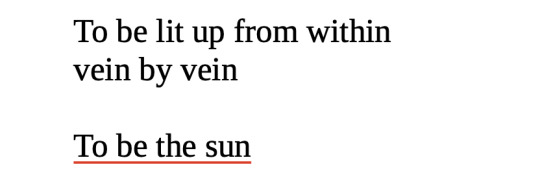
Margaret Atwood, from “Eating Fire”, Selected Poems: 1965-1975
7K notes
·
View notes
Photo

What Do You Do With an Idea written by Kobi Yamada, illustrated by Mae Besom
“One day, something amazing happened. My idea changed right before my very eyes. It spread its wings, took flight, and burst into the sky” -What Do You Do With an Idea
One day a young boy had an idea, which is represented in the form of a fragile little egg. At first, the boy is unsure what to do with the idea. He tries to leave it behind, but it follows him wherever he goes. As the boy considers his idea and nurtures it, it goes bigger and bringing color to the black and white pages of the book. When people tell the boy his idea is weird, he tried to lock it how. However, his idea can’t leave him be. Instead, he tries to feed it and help it grow into something magical, and as a result, he watched it transform before his eyes.
Winner of the 2015 Independent Publisher Book Award, What Do You Do With an Idea is beautifully crafted and illustrated. Mae Besom’s use of pencil sketches that gradually transform into vibrant watercolor images shows the progression of the idea hatching into a reality. After reading this story, students can brainstorm some of their ideas and share how they plan to turn them into realities.
Yamada, K. (2013). What Do You Do With an Idea. London, GB: Compendium.
What Do You Do With an Idea- $11.05 (Amazon)
0 notes
Photo
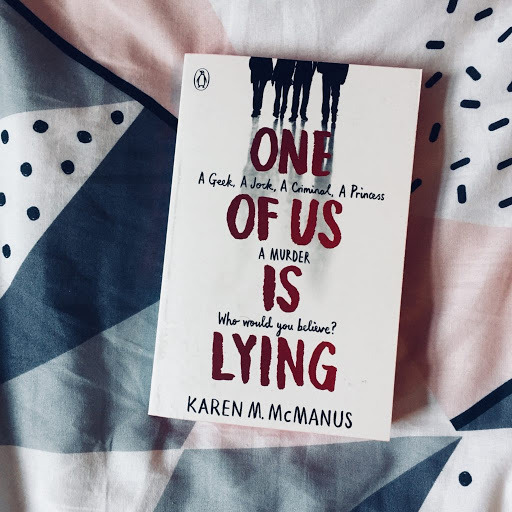
One of Us is Lying by Karen M. McManus
“I know what it's like to tell yourself a lie so often that it becomes the truth.” -Bronwyn, One of Us is Lying
Four teens: a brain (Brownyn), a jock (Cooper), a criminal (Nate), and a princess (Addy) find themselves serving detention one Monday afternoon for crimes none of them admit to committing. What start’s off as a cliche 80’s teen flick suddenly turns deadly when a fifth student, Simon, abruptly dies after taking a sip of water. When police discover that Simon’s water was laced with peanut oil, which Simon was allergic to, the other four students become suspects in his murder. As the mounting investigation gains national attention, each teen suddenly finds themselves social outcasts. Needing someone to confide in, the teens turn to one another for support knowing that Simon’s killer has to be among them.
Although it is at times predictable, One of Us is Lying is a perfect mixture of teen drama and suspense. Similar to other books on this blog, notably A Good Girl’s Guide to Murder, One of Us is Lying is a great story for students to piece together elements of a mystery. Even though A Good Girl’s Guide to Murder is more suited for a class study, One of Us is Lying is a good suggestion for similar reading.
McManus, K.M. (2017). One of Us is Lying. New York, NY: Delacorte Press.
One of Us Is Lying- $6.62
1 note
·
View note
Photo

The Boo-boos That Changed the World: A True Story About an Accidental Invention (Really!) written by Barry Wittenstein, illustrated by Chris Hsu
“I’ve GOT IT!,” Earle yelled with excitement… “What have you got?” Josephine asked. “The bloody solution, of course!” -The Boo-boos That Changed the World
At some point in your life, you’ve probably used a Band-Aid before, but have you ever wondered how the common household item came about? In The Boo-boos That Changed the World, Wittenstein hilariously recounts how Earle and Josephine Dickson invented the world’s most trusted bandage.
Accident-prone Josephine frequently received cuts and scrapes while tending to her house. As the son of a doctor, Earle knew how to treat his wife’s wounds, but he knew there had to be an easier way to go about it. By using some gauze and adhesive tape, Earle invented a rough prototype of the first Band-Aid. Impressed with his invention, Earle’s company, Jonhson & Johnson decided to mass-produce the product. In order to market the Band-Aid and increase its popularity with the general public, Johnson & Johnson sent out Band-Aids to the Boy Scouts and to soldiers fighting overseas during World War I. Soon, everyone wanted Band-Aids to mend their boo-boos. And the rest, as they say, is history.
An entertaining yet informative read, The Boo-boos That Changed the World is a great nonfiction resource to add to any elementary classroom or library. Teachers can use this picture book, along with other similar stories, to introduce students to the research process. Students can look up and examine how other inventions came about and present their findings to the class.
Wittenstein, B. (2018). The Boo-boos That Changed the World: A True Story About an Accidental Invention (Really!). New York, NY: Penguin Random House.
The Boo-boos That Changed the World- $13.65 (Amazon)
0 notes
Photo

A Good Girl’s Guide to Murder by Holly Jackson
’“The people you love weren’t algebra: to be calculated, subtracted, or held at arm’s length across a decimal point.” -Pip, A Good Girl’s Guide to Murder
Five years ago Fairview High School senior, Andrea “Andie” Bell, went missing. Three days later the body of her boyfriend, Sal Singh was found in the woods, dead from an apparent suicide. Even though the body of Andie was never discovered, detectives assumed she was murdered by her boyfriend. It was an open and shut case. Since then, the residents of Fairview have treated the Singh family as social pariahs. Everyone believes Sal murdered Andie, everyone that is, except Pip Fitz-Amobi. For her senior capstone project, Pip decides to reexamine the case herself to try to find justice for Andie and Sal’s killers. Joined by Sal’s brother, Ravi, the two interview those closest to the two teens and retrace the last few days of their lives. When Pip starts to receive anonymous threats from someone involved in the murders, she may be closer to Andie and Sal than she ever realized.
Fans of Serial and other true crime podcasts will love A Good Girl’s Guide to Murder. Just when you think you have figured out the mystery, Jackson delivers twist after shocking twist. This is a novel that will have students engaged throughout the learning process, and eagle-eyed readers will be able to piece together clues and bits of foreshadowing to solve the case before the novel’s big reveal.
Jackson, Holly. (2020). A Good Girl’s Guide to Murder. New York, NY: Penguin Random House.
A Good Girl’s Guide to Murder- $14.39 (Amazon)
0 notes
Photo
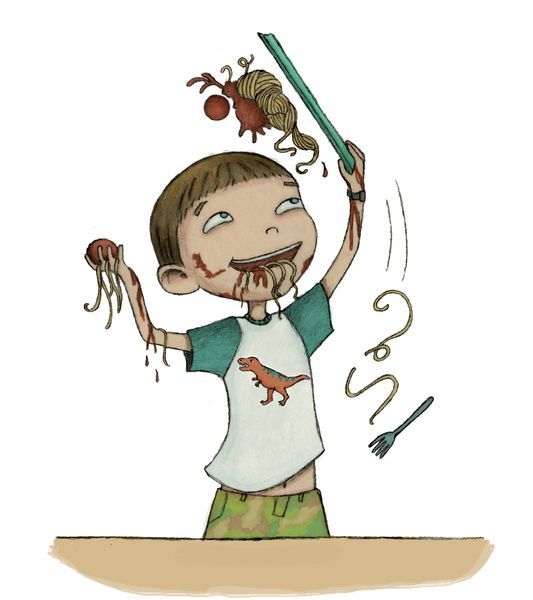
Spaghetti is Not a Finger Food (and Other Life Lessons) written by Jodi Carmichael, illustrated by Sarah Ackerly
“I’m just so tired of always getting things wrong. I’m tired of getting in trouble” -Conner, Spaghetti is Not a Finger Food
Told through the voice of Conner, an eight-year-old boy with Asperger's Syndrome, Spaghetti is Not a Finger Food is a hilarious story about Conner struggling through an especially rough day of school.
Sometimes Conner feels like there is a lot of information in his head that gets jumbled up and needs to be let out. He knows lots of facts, especially about dogs and dinosaurs, and feels like he should share this information with anyone that will listen. However, Conner’s teachers and classmates feel otherwise. All Conner whats to do is to make people like him. Why do they have so much trouble understanding that? Connor attempts several times throughout the day to impress the people around him, but instead, he leaves a path of destruction in his wake. Conner’s teachers think he is being disruptive to the class environment, even though he swears he didn’t mean to cause chaos. Thankfully, Mrs. Rosetti, the school counselor, is there to help. She suggests that Conner take three deep breaths before responding to a situation. When a stay dog finds its way into the school, Conner uses his knowledge about dogs and Mrs. Rosetti’s advice to help save the day.
Spaghetti is Not a Finger Food is an excellent story that teaches young students about how some people’s brains work differently than others. Although the book never explicitly says Conner has Asperger's Syndrome, mature readers are able to imply through context and dialogue his condition. Books with neurodiverse protagonists seem few and far between, so it is refreshing to see a character with a neurological disorder represented in children’s literature. Spaghetti is Not a Finger Food offers students and teachers an opportunity to have meaningful conversations about choices, consequences, and what it means to be a good friend.
Carmichael, J. (2012). Spaghetti is Not a Finger Food. Naperville, IL: Little Pickel Press.
Spaghetti is Not a Finger Food- $6.95 (Amazon)
0 notes
Photo
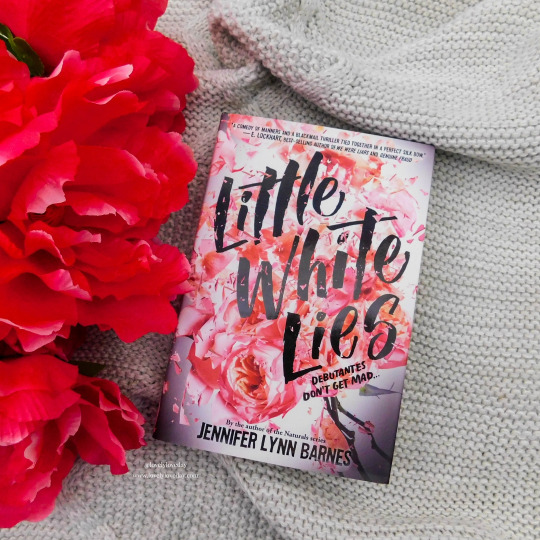
Little White Lies by Jennifer Lynn Barnes
“I'm not saying this is Sawyer's fault, but..." -Lily, Little White Lies
Born to a flighty teenage mother, Sawyer Taft has had to play the role of adult for as long as she can remember. She pays the bills, works a part-time job as a mechanic to make ends meet, and does almost all the general upkeep around the house. The only person Sawyer has ever counted on is herself. So, of course, Sawyer was surprised when her regal grandmother, Lillian Taft, shows up on her doorstep offering her the chance of a lifetime. If Sawyer will live with Lillian for the next nine months and complete a full debutante seasonーbecoming a proper Southern belleーthen Lillian will give Sawyer $500,000 for college. Skeptical, Sawyer questioned her grandmother’s motives. Lillian kicked Sawyer’s mother out of the house when she found out her daughter was pregnant. She’s never had anything to do with Sawyer, so why start now? But when Lillian promises that moving in with her will help Sawyer uncover the identity of her biological father, the offer is too good to pass up. And so Sawyer is whisked away into the world of old Southern money, tradition, and deep hidden secrets. As the lies and double lives of the people her mother left behind eighteen years ago begin to reveal themselves to Sawyer, only one thing is certain: no one is as they seem.
The first book in Barnes’ Debutante series, Little White Lies is the perfect mix of humor and mystery. Although the book doesn’t have any educational merit, students will nonetheless be drawn to its witty characters. Fans of the Pretty Little Liars series will love Little White Lies. For its entertainment value, Little White Lies comes recommended for school libraries.
Barnes, J.L. (2018). Little White Lies. Glendale, CA: Freeform and Disney.
Little White Lies- $9.99 (Amazon)
0 notes
Photo
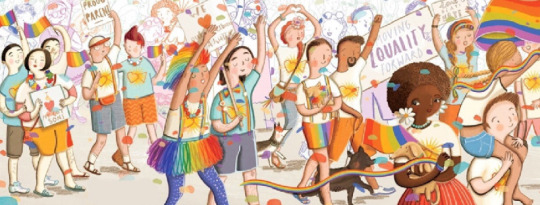
This Day in June written by Gayle E. Pittman, illustrated by Kristyna Litten
“This day in June we are all united” - This Day in June
Set during a Pride parade celebration, This Day in June is a children’s book that explores the culture and pride of the LGBT community. Filled with colorful images and positive affirmations told in couplets, This Day in June allows members of the LGBT community to see themselves represented in children’s literature in a way that acknowledges and celebrates their worth as a family unit. After the text, Pitman includes a teacher and parent discussion guide that teaches students the history of Pride, along with appropriate discussion prompts for various age levels.
While some may argue that the book’s depiction of two men kissing isn’t appropriate for young audiences, it is important that school classrooms and libraries offer books that represent the culture and lifestyles of all their students, especially those in the younger grades. Teachers wishing to use this book in the classroom can use Pitman’s discussion guide as a springboard for learning, and also include activities about tolerance.
This Day in June was featured on the 2015 Rainbow Project Book List and won the 2015 Stonewall Children’s and Young Adult Literature Award.
Pittman, G.E. (2014). This Day in June. Washington D.C.: American Psychological Association Magination Press.
This Day in June- $12.30
#childrens literature#children's books#lgbtq books#lgbt#books#book review#Book Recommendations#goodreads
4 notes
·
View notes
Photo

Smile written and illustrated by Raina Telgemier
“Weird...something happens when you smile at people. They smile back” -Raina, Smile
In Smile, her autobiographical graphic novel, Raina Telemier details the long and tedious process she had to go through as a teenager in order to have a nice smile. It all started one night after a Girl Scout meeting when Telgemier fell, causing her two front teeth to fall out. This ordeal lead to years of braces, surgeries, false teeth, and root canals. Told over the course of several years, Telgemier recounts first crushes, broken friendships, and self-acceptance with humor and wit.
Like all of her graphic novel, Telgemier’s cartoon-like illustrations and vibrant colors pop on the page. Telgemier’s candid narrative is easily relatable and will leave students wanting to read the other books in her Eisner winning biographical series.
Telgemier, R. (2010). Smile. New York, NY: Scholastic.
Smile- $7 (Amazon)
#graphicnovel#middle school#YA Books#YA literature#nonfiction#books#book review#Book Recommendations#goodreads
0 notes
Photo

With Malice by Eileen Cook
“Who we are is what comes out when shit goes bad. You can't tell anything about a person when things are great. If you want to really know someone, be there when everything goes to hell.” -Anna, With Malice
Eighteen-year-old Jill Charron had everything going for her: good friends, an acceptance letter to Yale in her pocket, and a school trip to Italy to look forward to. That was before the accident. When Jill wakes up in the hospital after the car she was driving crashed into a brick wall in Florence, the last thing she can remember was attending her school’s production of Grease. That was over six weeks ago. Disoriented, she begs her mother and doctors to let her best friend Simone visit so that she can piece together her trip to Italy. However, Simone died in the accident. Even worse, authorities suspect that the accident might have been part of a murder-suicide attempt. That couldn’t be possible though, because Jill loved Simone. She would never do anything to harm her best friend. Before Jill can truly process what has happened, text messages from Simone and Jill are released to the public. National media begins to pick up the story, and suddenly Jill’s perfect reputation is being torn apart over social media. Slowly, as bits and pieces of her Italian trip start to come back to her, Jill realizes that her friendship with Simone wasn’t as perfect as she thought it was. Even so, did she really murder her best friend?
Although a bit predictable, With Malice is a suspenseful novel that will captivate teen readers. Good girl Jill is villainized by the media, but all is not as it seems. Because social media plays an important part in the narrative of the story, students and teachers will be able to discuss the roles perception and morality play in our society.
Cook, E. (2016). With Malice. New York, NY: Houghton Mifflin Harcourt.
With Malice- $9.99 (Amazon)
#mysyery#suspense#YA Books#YA literature#ya fiction#books#book review#Book Recommendations#goodreads
0 notes
Photo
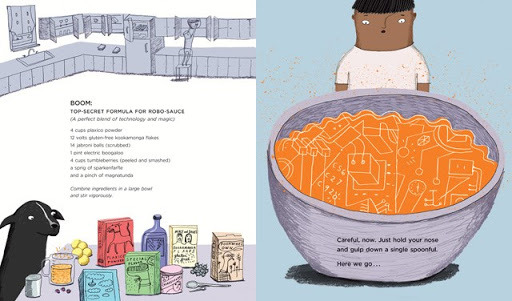
Robo-Sauce written by Adam Rubin, illustrated by Daniel Salmieri
“Activate robo-domination...the end is near” - Robo-Kid, Robo-Sauce
Wacky and irreverent, Robo-Sauce is about a young boy who creates a zany concoction that turns people into robots. After pouring the sauce on himself, the boy transforms himself into Robo-Kid, a massive robot that can shoot lasers from its eyes and crush cars like tiny insects. However, life becomes lonely fast once people begin hiding out in fear from Robo-Kid. Instead of using the antidote recipe, Robo-Kid destroys it and begins turning everyoneーhis family, neighbors, animals, even the bookーinto robots bent on world domination.
Young readers are sure to love Rubin’s wacky story that celebrates imagination and creativity. After reading Robo-Sauce, elementary students can write stories of their own based on crazy inventions or ideas.
Rubin, A. (2015). Robo-Sauce. New York, NY: Penguin Random House.
Robo-Sauce- $11.99 (Amazon)
2 notes
·
View notes
Photo

The Book of Essie by Meghan MacLean Weir
“It’s men who trust they will suffer no consequences for their actions, while women suffer no matter what they do.” -Roarke, The Book of Essie
Seventeen-year-old Essie Hicks has spent her entire life一literally一 in front of the camera. The youngest daughter of a strict evangelical preacher, Essie’s family has starred in the reality show Six for Hicks since before Essie was born. Essie’s family projects straight-laced morals and religious values every week for all the world to see. Despite their wholesome image, the family has dark secrets bubbling under the surface. One of those secrets is that Essie is pregnant. In order to protect the family’s reputation, the producers of the show meet with Essie’s mother to discuss their options. Essie can either have an abortion, hideaway until she delivers the baby and then give it up for adoption, or get married (very, very soon). And thus enters Roarke Richards, a boy at Essie’s school who has secrets of his own. He agrees to marry Essie so that together, along with journalists Liberty Bell, they can publicly expose Essie’s family and the corrupt misdeeds of church Essie and Roarke both attend.
While it is obvious at times that plot points from the novel mirror the headline scandals of TLC’s Duggar family, The Book of Essie is still a gripping page-turner that I couldn’t put down. Similar to another novel on this list (The Love and Lies of Rukhsana Ali), The Book of Essie features instances of physical and emotional abuse, sexual assault, and homophobia. While reading this book students can discuss how fame gives people a warped sense of entitlement. More mature readers can compare and contrast religious violence featured in this book, as well as The Love and Lies of Rukhsana Ali.
The Book of Essie is a 2019 Alex Award winner.
MacLean Weir, Meghan. (2018). The Book of Essie. New York, NY: Penguin Random House.
The Book of Essie- $12.99 (Amazon)
1 note
·
View note
Photo
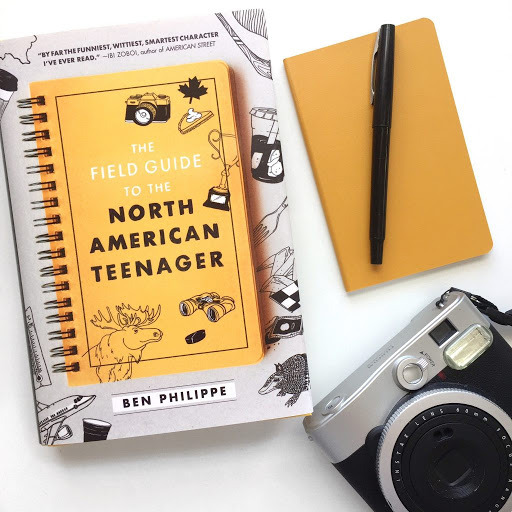
The Field Guide to the North American Teenager by Ben Philippe
“We all mess things up. It’s what you do with the mess that matters.” -Felix, The Field Guide to the North American Teenager
“Don’t let your mouth get you into trouble,” that’s the advice Norris Kaplan’s mother givers him before his first day of school in American. The son of divorced Haitian immigrants, Norris was satisfied with his quiet life in Quebec. There he had friends, hockey, and most importantly, he had cool weather. When his mother gets a job as a professor at the University of Texas at Austin, Norris is forced to upend his life and transfer to school in America. At his new school, Norris struggles to fit in, mostly due to his stereotypical Canadian manners and sarcasm. But at least Norris has his journal, where he documents the strange habits and actions of his fellow classmates. Eventually, Norris befriends a cheerleader named Maddie, who promises to help Norris get a girlfriend in exchange for random personal favors. However, when an incident at prom happens that causes Norris’ journal to get stolen, the truth about what he thinks about certain classmates comes spilling out.
Fans of John Green will love Philippe’s coming-of-age debut novel. Based on Philippe’s real-life experiences as a Canadian transplant, The Field Guide to the North American Teenager is a witty and entertaining read that teens will be sure to love. With themes focused on identity, peer pressure, and first love, teachers and students will have plenty to discuss.
Philippe, B. (2019). The Field Guide to the North American Teenager. New York, NY: Blazer + Bray.
The Field Guide to the North American Teenager- $9.87 (Amazon)
1 note
·
View note
Photo
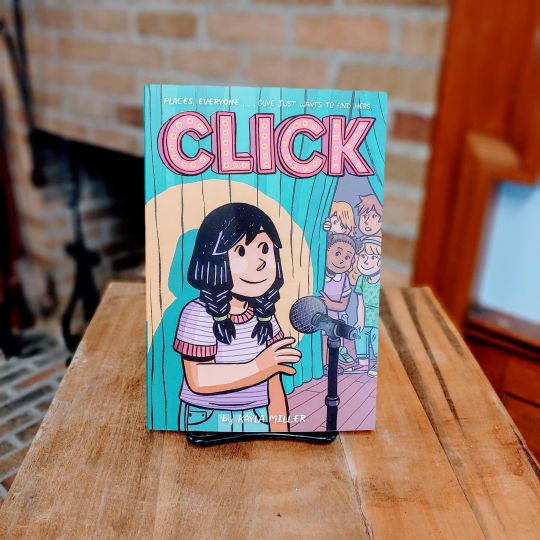
Click written and illustrated by Kayla Miller
“There’s nothing wrong with wanting to stand out a little” -Aunt Molly, Click
Olive has no shortage of friends at her school. Outgoing and exuberant, she’s the type of girl that fits in well with almost everyone. When the 5th grade variety show is announced Olive can’t wait to perform in front of an audience. There’s only one problem, though, no one asked Olive to join their group. Is it possible to feel isolated yet still have friends? A weekend away with her offbeat aunt Molly helps Olive realize that being alone doesn’t necessarily have to be a bad thing. Instead of being part of a duo or group, Olive decides that she will host the variety show all on her own.
In her debut graphic novel, author Kayla Miller delivers a refreshing take on fitting in and finding one’s own role within a group. Where similar middle school stories center their plots around exterior motives, Olive’s journey is more of an introspective one. Even though she wasn’t asked to participate in a variety act, Olive’s friends never activity excluded her from the group. Click teaches young students that fitting in has looks different for different people, and that that is okay.
Miller, K. (2019). Click. New York, NY: Houghton Mifflin Harcourt.
Click- $6.29 (Amazon)
#graphicnovel#middle school#childrens literature#children's books#YA Books#books#book review#Book Recommendations
0 notes
Photo

Sulwe written by Lupita Nyong’o, illustrated Vashti Harrison
“Brightness is not from your skin, my love. Brightness is just who you are.” -Mom, Sulwe
Written by Academy Award-winning actress, Lupita Nyong’o, Sulwe is an empowering children’s book about self-acceptance.
Sulwe hates that her skin is darker than the other members of her family, and is often teased at school for her complexion. Sulwe equates light skin with beauty and tries everything she can think of to make her skin a lighter shade, like rubbing her skin with an eraser, eating lighter foods, and even praying. When Sulwe voices her concerns to her mother, her mom reassures her than she is beautiful just the ways she is, and that true brightness comes from within.
Winner of the NAACP Image Award for Children’s Literature, Nyong’o draws form both mythology and her own experience to bring Sulwe to life. Sulwe is essential for any elementary classroom or school library because it teaches students to love their bodies and to let the inner beauty shine brightly for all to see.
Nyong’0, L. (2019). Sulwe. New York, NY: Simon & Schuster.
Sulwe- $14.22 (Amazon)
#childrens literature#children's books#books#book review#Book Recommendations#goodreads#lupita nyong'o
3 notes
·
View notes
Photo
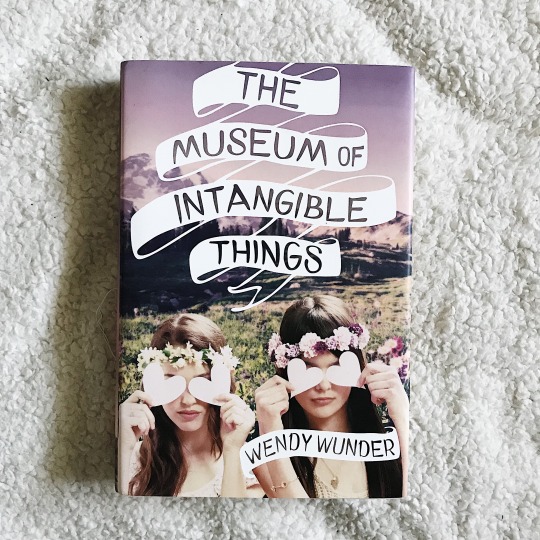
The Museum of Intangible Things by Wendy Wunder
“Perfect should never be a goal. Perfect just happens if you let it.” -Zoe, The Museum of Intangible Things
Hannah and Zoe have been best friends for as long as they both can remember, despite begin complete and total opposites. Hannah is the straight-laced honor student that just wants to maintain the status quo, while Zoe is the spontaneous wild child that relishes her every desire. Neither girl comes from a supportive family, so in many ways, they are all the other one has. Due to Zoe’s manic depression and bipolar disorder, Hannah often feels responsible for her friend and often acts as Zoe’s moral compass.
After an incident at a house party triggers a manic episode out of Zoe, Hannah agrees to travel across the country with her best friend, on what promises to be the road trip of a lifetime. This bout of mania is different for Zoe, however, and Hannah can’t reign in Zoe’s reckless indulgences. When Zoe starts claiming that aliens are coming for her, Hannah will do whatever it takes to save her friend from spiraling out of control.
Although the book started out with promise, too many dangling plot points and unanswered questions caused The Museum of Intangible Things to fall flat. The book is packaged as a coming-of-age road trip story, however, somewhere along the way Wunder steers her characters into one strange and improbable circumstance after another, causing the novel to drift into magical realism during the last half of the story. I’m sure there is an audience for the book out there somewhere, but it has no place in the classroom curriculum.
Wunder, W. (2014). The Museum of Intangible Things. New York, NY: RazorBill.
The Museum of Intangible Things- $10.98 (Amazon)
0 notes
Photo
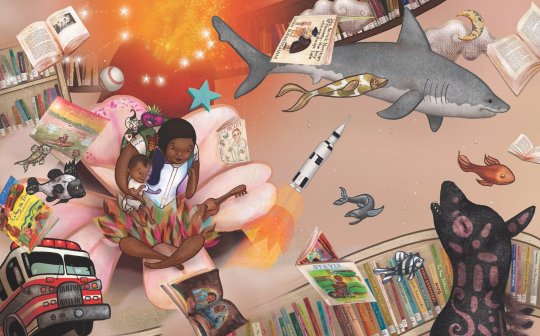
Dreamers by Yuyi Morales
“Books became our language. Books became our home. Books became our lives.” -Yuyi, Dreamers
Based on Yuyi Morales’ life as an immigrant moving from Mexico to the United States, Dreamers is a visually stunning picture book that encapsulates the hopes, aspirations, and fears of leaving behind the only way of life you’ve ever known in favor of better opportunities.
As a young mother, Morales dreamed of a better life for her son. Together, the two of them “crossed a bridge outstretched like the universe” and began a new life together in San Francisco. Morales was unable to speak English when she first moved to America. She details in vibrant illustrations the many trials and errors she experienced during her first few weeks in the U.S., like letting her son play in a public water fountain. Instead of letting the language barrier get in her way, Morales found her way to the library where she read all the books she could get her hands on until she became fluent in English. Morales ends the story by telling her son how resilient the two of them are because of all the things they went through in order to achieve hope and possibility in a forigne land.
Winner of the 2019 Pura Belpre Illustration Award, Dreamers is a love letter to the immigrant experience. In her author’s note, Morales very poignantly states that she and her son were not Dreamers in the political use of the world, but dreamers because in the sense that they “entered a new country carried by hopes and dreams, and carrying our own special gifts, to build a better future”. This book is an excellent resource to have in the classroom or school library to teach students about immigration.
Morales, Y. (2018). Dreamers. New York, NY: Holiday House Publishing.
Dreamers- $13.29 (Amazon)
#nonfiction#childrens literature#children's books#hispanic culture#books#book review#Book Recommendations#illustration#goodreads
4 notes
·
View notes